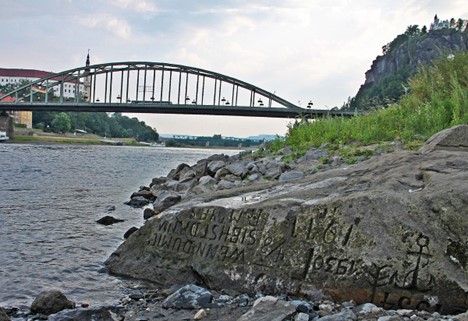SOURCE:
A story published by the Business Insider among other media outlets today cites the reappearance of “hunger stones,” in dry European creek and riverbeds as evidence climate change is responsible for the current drought in Europe. This is false.
If anything the fact that these stones have “reappeared,” and have been uncovered multiple times in the past, shows severe droughts have been common throughout European history. There is no more evidence that human activities are the source of the present drought, than existed when droughts and crop failures happened in the past when some were blamed on witches.
In the story, titled “A historic climate-fueled drought in Europe revealed ominous, centuries-old ‘hunger stones’ warning of hardship,” Business Insider writer Paola Rosa-Aquino says the fact that “hunger stones” stones have been uncovered as water levels have fallen across many areas of Europe during the present drought provides evidence climate change is responsible for the drought.
“An intense drought is shrinking rivers across Europe, revealing stones carved centuries ago to give future generations a warning of hard times ahead,” writes Rosa-Aquino. “A growing body of research links intensifying droughts in many parts of the world to climate change.
“Researchers say the current drought that Europe is experiencing could be the worst in 500 years,” Rosa-Aquino says.
Rosa-Aquino’s claim that droughts are intensifying is refuted by the United Nations Intergovernmental Panel on Climate Change’s most recent report. Although to the media a drought is a drought, in its 2021 Sixth Assessment report, the IPCC distinguishes four categories of drought: hydrological, meteorological, ecological, and agricultural. The IPCC finds no evidence climate change has increased the number, duration, or intensity of hydrological or meteorological droughts, and it has only medium confidence it has “contributed to changes in agricultural and ecological droughts and has led to an increase in the overall affected land area.”
Even for ecological and agricultural droughts the data is a mixed bag. The IPCC divides the world into 47 separate regions of study when analyzing drought trends, and its data suggest ecological and agricultural drought may have increased during the period of modest warming in 12 of those 47 regions. However, in only two of those regions does the IPCC have even “medium confidence” for any human role in the observed increase. For the remaining regions experiencing a possible increase in droughts, the IPCC has low confidence human activities have had any discernible impact.
As Climate Realism has noted in numerous past articles, here, here, and here, for example, droughts around the world are weather events that may last a few years, but are hardly unprecedented in Earth’s history, even in Europe.
Concerning the message the hunger stones are sending one must understand what they are and their history. Wikipedia describes hunger stones as:
a type of hydrological landmark common in Central Europe. Hunger stones serve as famine memorials and warnings and were erected in Germany and in ethnic German settlements throughout Europe in the 15th through 19th centuries.
These stones were embedded into a river during droughts to mark the water level as a warning to future generations that they will have to endure famine-related hardships if the water sinks to this level again.
One certainly can’t cite the hunger stones to establish that the present drought is the worst in the past 500 years. Photos of the hunger stones accompanying the Business Insider article show Europeans experienced droughts equal to or more severe than the present one in 1417, 1616, 1707, 1746, 1790, 1800, 1811, 1830, 1842, 1868, 1892, and 1893. Nor can one cite other direct data to support the assertion, because none exists for the past. All we can say for sure is that creeks, streams, and rivers have run dry historically on multiple occasions in Europe during past severe droughts long before humans began emitting substantial amounts of greenhouse gases into the atmosphere. The best evidence suggests that nature, not human caused climate change, rules drought periods and cycles now as it has throughout the Earth’s history.
Journalists should check the data and think about what history actually tells present generations before claiming this or that extreme weather event is unmatched in history or is caused by climate change. Rosa-Aquino’s Business Insider story notwithstanding, there is no evidence Europe’s present drought is caused by climate change.
